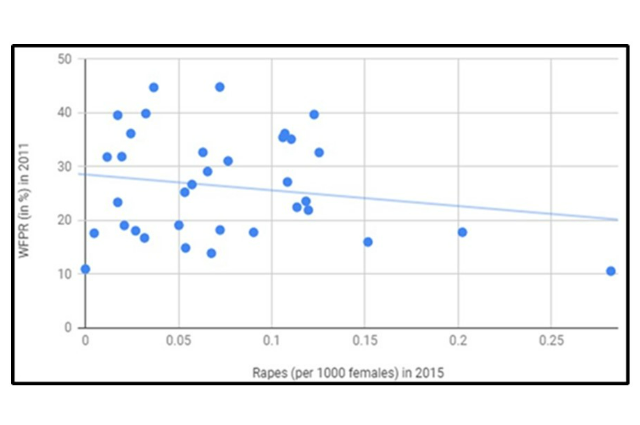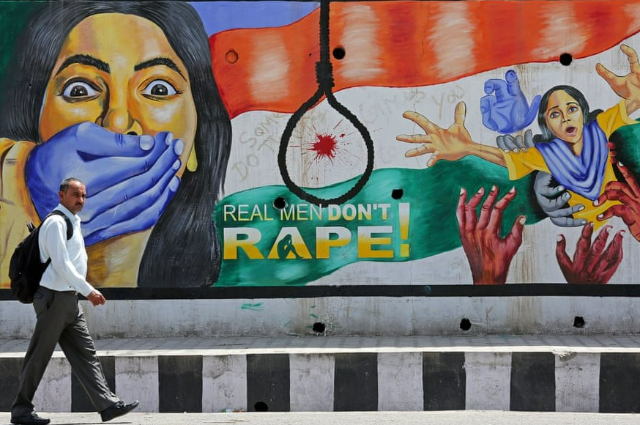ABSTRACT
Female labour force participation rate (FLPR) has been historically low in India and surprisingly, has been declining over the past few years. It has fallen from 36% in 2005-06 to 24% in 2015-16, as per the Economic Survey of India 2017-18. One important, and often ignored, explanation for these trends in the Indian context is the high prevalence of crime against women. The incidence of rapes — marital or otherwise — has been on a rise in India in the past decade (Government of India, 2017), so much so that India is now infamous for being the ‘Rape Capital’ of the world. The question that then arise is, if there is a strong causal relationship between such events and their aftermath? Does the prevalence of sexual crime against women constraint them financially or professionally, making their contribution to growth smaller compared to their male counterparts? Rising per capita income levels notwithstanding, the increasing cases of sexual abuse do have a negative impact on the workforce participation by women, thereby hindering the economic growth and development of the country.
INTRODUCTION
The economic cost of rape incidents is very huge which has a large opportunity cost for any economy. The victims of rape bear large health and legal repercussions. Additionally, they suffer from a lifelong reduction in productivity which constrains the country from reaching its potential (Peterson et al., 2017). These costs, though large, are not restricted to the immediate victims; rather, they spill over to the overall female population of the country. Living with the constant threat of abuse, females have to take precautionary measures, staying at home for instance, in order to prevent getting victimised. These measures, unfortunately, can also prevent them from attaining desirable education levels (Bowen and Bowen, 1999; Schwartz and Gorman, 2003; Ceballo et al., 2004) or joining the workforce in some situations (Chakraborty et al., 2015).
1. WORK DECISIONS OF THE VICTIMS
Various short-term and long-term, physical and mental health problems are associated with rapes of women. Post Traumatic Stress Disorder, anxiety disorders and depression are not uncommon among the victims, with serious implications on the educational attainments and productivity of women in the workplace. Due to the mental trauma, they are usually unable to perform to the best of their potential, at least in the short run, which leads to the reduction in the wages earned by them (if they decide to participate in the labour force) (Sabia et al., 2013). Some women even quit working because of the emotional turmoil they go through — accruing to the mistrust they develop for strangers and the social exclusion and stigma they face. The outcome of this decision may, in some cases, be seen as good by individuals (for prevention is better than cure), however, the ramifications on the economy are enormous in terms of lost human capital and productive potential.
Having talked to a few victims, we have observed their tendency to get involved in the non-profit sector focussing on equality, social justice and generally raising awareness about the sexual assault. It is because of the compulsion they feel towards doing something which others did not do for them. However, this involvement in activities affects their professional trajectories by trading off the time that could have been used in more productive areas which directly add to the GDP of an economy.
2. RIPPLE EFFECTS ON THE SOCIETY
Apart from the impact on the work decisions of the victims, rape incidents also alter the behaviour of the overall population. Be it by the prospective female employees or the employers, sexual abuse effects the decisions made in the labour market.
2.1 Female Job Seekers
There has been a surge in the number of police reports for rapes recently. With awareness comes the perception of the crime. The perceived threat of crime against women is likely to have increased because of the extensive media coverage that has been seen in India after the horrifying Nirbhaya case. A constant perceived threat to their safety reduces the flow of women into the labour force to a trickle (Chakraborty et al., 2015). Firstly, the possibility of getting sexually abused has a positive relation to the girls’ absenteeism rate in schools.
Bowen and Bowen (1999), Schwartz and Gorman (2003), Ceballo et al. (2004) have studied the negative effect of exposure to violence in the neighbourhood on attendance rates and education outcomes. This deterrent is even stronger in areas which are isolated, where children have to travel long distances in order to attend school or where the society has reservations about girls learning, let alone stepping out of their homes to go to school. This seriously impedes the development of human capital, which, in turn, reduces the employability and employment opportunities of these girls. And this doesn't end here. It gives birth to a domino effect of deteriorating human capital, as the off-springs of these girls when they become mothers, are shown to perform worse in attendance and academic achievements (Awan and Kauser, 2015).
Secondly, in order to prevent getting victimised, females may choose to stay at home or be reluctant to devote more hours to the workforce, especially in night shifts. In their recent research, Chakraborty et al. (2015) argue that the cost of participating in the workforce increases for the women when the perceived threat of crime against women is high and this deterrent effect is stronger in traditional societies where the chances of stigmatisation are large. This self— and many times socially— imposed restriction affects the type of occupations women find appropriate for themselves. This obviously prevents the economy to exploit the human capital it has while foregoing the potential innovation advancements it may have had.
The following scatter diagram plots the female workforce participation rate as a percentage of the female population (as per the Census data 2011) against the number of rape cases in different states and union territories in India during 2015 per female population in the region (as per the Census data of 2011). The relationship is clearly negative, implying the possible downward pressure rape incidents put on the work decisions made by the women.

Figure 1: WFPR (in%) vs Rape (per 1000 females) in the Indian States
Source : Author’s calculations based on Census 2011 data on female workforce participation rates and female population, and the data on state-wise incidents of crime against women in 2015 published by the National Crime Records Bureau, Ministry of Home Affairs.
2.2 Behaviour of the Employers
The employers are also aware of this reluctance of a large proportion of the female population to commit long hours at the workplace which makes the employers make an irrational value assessment of the potential of the female job seekers, a concept which has been much discussed recently. The employers expect all the female workers to be less productive just because of their doubts about their commitment to the jobs. In consequence, the wages or salaries offered to them are often less as compared to their male counterparts, as shown by Sabia et al. (2013) also. In fact, a new study by Bolotnyy and Emanuel (2018) shows how the unwillingness to accept overtime -shifts by female train and bus drivers lead to lower wages for women when compared to men. The aftermath of this discrimination is an underperformance by the female employees. This hypothesis makes an assumption that the actual work performance of the employees is positively correlated with the remuneration offered to them. With nearly half the working-age population falling prey to such notions of lower productivity, they have serious negative implications on the growth of all the sectors of an economy.
Thus, the ability of the prevalence of rape incidents to counter growth and development is overwhelming, especially in a developing country such as India, and must be addressed in order to curb its ability to put speed breakers on the road to success.
3. POTENTIAL SOLUTIONS
Building robust legal institutions may play a key role in curbing crimes against women and thereby, improving their labour force participation. Conviction rates and reported cases of rapes show a small positive correlation indicating that higher probability of conviction encourages the reporting of rapes, at the same time acting as a deterrent for the same (which could be a factor behind the small correlation). Making reporting of crimes easier, the prosecution and redressal processes faster along with greater awareness about the crimes and associated punishments is imperative. (Bandyopadhyay, 2018).
CONCLUSION
Improving the social status of women remains a big challenge in India’s patriarchal society, but holds vast potential for positive change. A negative correlation exists between sex ratio, a proxy for the position of women in the society, and reported cases of rape. Gender pay gaps are more severe in Japan and South Korea than India, yet their female LFPR far outstrips that of the latter, notes Amsden (1989). One important underlying cause could be the stark difference in crime rates in these countries. Extensive awareness programs, reaching the nooks and crannies of the country, along with real-life examples of successful females, holistic education in schools and addressing these pressing issues, will go a long way in orchestrating a change. The media is also a powerful weapon, which can either amplify the distortions in the social mindset or play a huge helping hand in improving the same. The outcome not only depends on those who wield it but also the ‘passive’ viewers who can (and ought to) raise their voices whenever needed.
. . .
END NOTES:- Awin, A. G., & Kauser, D. (2015). Impact of Educated Mother on Academic Achievement of her Children: A Case Study of District Lodhran- Pakistan. Journal of Literature, Languages and Linguistics,12, 57-66. Retrieved from www.iiste.org.
- Bandyopadhyay, S. (2018, May 8). A Closer Look at Statistics on Sexual Violence in India. Retrieved from thewire.in/society
- Bolotnyy, V., & Emanuel, N. (2018). Why Do Women Earn Less Than Men? Evidence from Bus and Train Operators (Job Market Paper). Working Paper.
- Bowen, N. K., & Bowen, G. L. (1999). Effects of crime and violence in neighborhoods and schools on the school behavior and performance of adolescents. Journal of Adolescent Research, 14(3):319–342.
- Ceballo, R., McLoyd, V. C., & Toyokawa, T. (2004) The influence of neighborhood quality on adolescents educational values and school effort. Journal of Adolescent Research, 19(6):716–739.
- Department of Economic Affairs, India, Ministry of Finance, Government of India. (2018). Annual Economic Survey 2017-18.
- Dhillon, C. S. (2018, May 1). India’s female labour force is declining. The Tribune. Retrieved from www.tribuneindia.com
- Government of India. (2017). Selected Socio-Economic Statistics 2017 (India, Ministry of Statistics and Programme Implementation, Central Statistics Office, Social Statistics Division). New Delhi.
- Jain, P. (2018, June 27). 5 Behavioral Economics Principles Marketers Can't Afford to Ignore. Retrieved from www.forbes.com.
- Peterson, C., DeGue, S., Florence, C., & Lokey, C. N. (2017). Lifetime Economic Burden of Rape Among U.S. Adults. American journal of preventive medicine, 52(6), 691-701.
- Sabia, J., Dills, A., & DeSimone, J. (2013). Sexual Violence against Women and Labor Market Outcomes. The American Economic Review, 103(3), 274-278. Retrieved fromwww.jstor.org.
- Schwartz, D., & Gorman, A. H. (2003). Community violence exposure and children’s academic functioning. Journal of Educational Psychology, 95(1):163.
- Tanika Chakraborty et al., Crime and Women’s Labor Force Participation, www.isid.ac.in/pdf listed as 2015 in iitk.ac.in/pdf.
- The World Bank. (2018, September). Labor force, female (% of total labor force). Retrieved from data.worldbank.org
- World Health Organisation. (2017, November 29). Violence against women. Retrieved from www.who.int.


